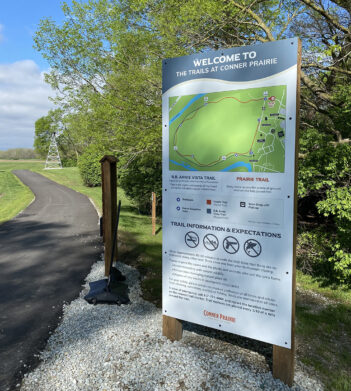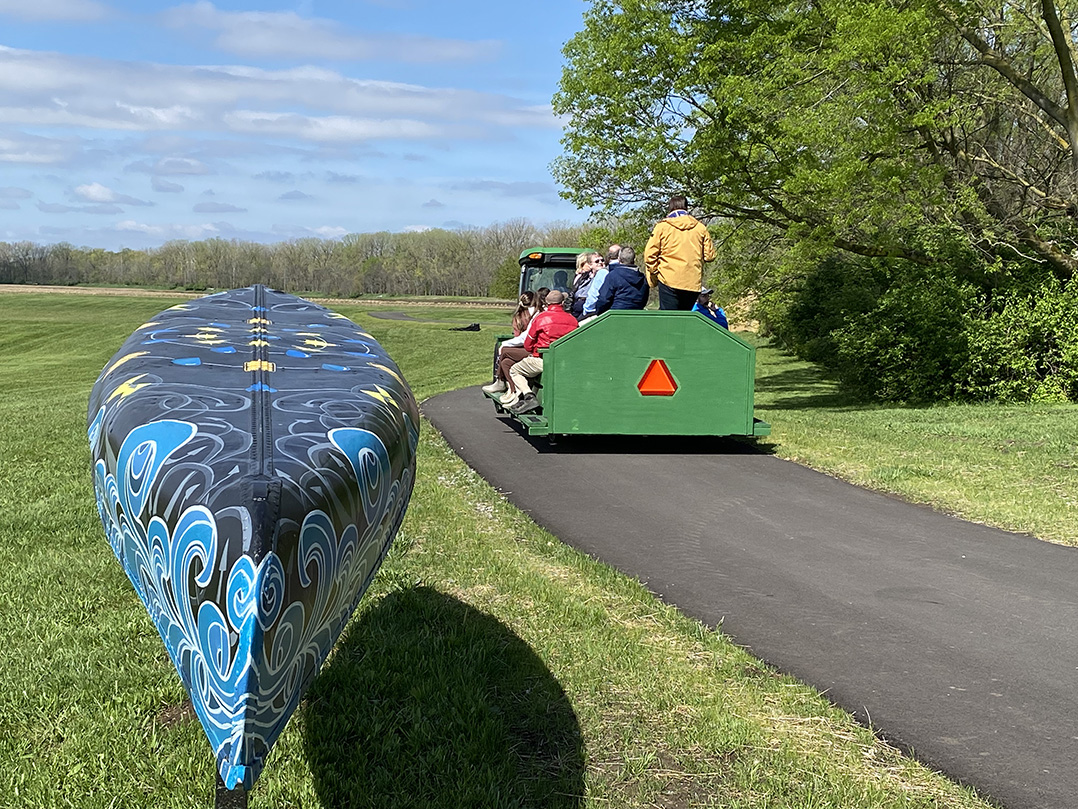During a celebration of the new Trails at Conner Prairie, the Fishers-based outdoor museum’s President and CEO Norman Burns began his part of the presentation with a moment of silence — not in remembrance of any individual, but to honor the sounds of nature surrounding the peaceful location.
“You’re hearing the land and the river speak to you,” he said. “And that’s really what this unique place is — Conner Prairie is a unique place, always will be, and what we’re doing with our master plan, what we’re doing with this land, what we’re doing with this river is very unique.”

Conner Prairie’s new trails system consists of two 2-mile trails. One is paved and accessible for people with disabilities and the other — which takes walkers up onto a berm — is more rugged, with a gravel tread. They are both part of the museum’s master plan with a goal of bringing more people out to see everything Conner Prairie has to offer.
Burns recalled when he first came to Conner Prairie in 2016 and spent many hours walking on the berm, which was installed in the 1940s to control flooding for farmland.
“I’d walk along the berm all the way around and see nature, see the river and think to myself, ‘Why are more people not engaging with this?’” he said, adding that the master planning process started soon after. “We were looking at these 1,046 acres of land and 3.3 miles of river — we wanted to make sure that we develop things that would engage people.”
Conner Prairie Vice President Andrew Bradford said the new trails will help educate the public about the importance of habitat preservation.
“What we are excited about is the culmination of years of work to think about these 260 acres, to think about the White River that runs directly through the center of our property and how can we use that to educate people about the role these waterways play in our everyday lives?” he said. “How can we educate people about the fact that this is the drinking water? How can we get people to understand that it is the ecosystem that supports the habitats that make sure we’ve got healthy bee populations and the butterflies that we want in our backyards?”
He said they worked with the Indiana Wildlife Federation on some of those questions, and the the new trail system is now certified as sustainable.
A ribbon cutting and a flurry of photos followed the official presentations at the event.
Later, as visitors waited for a tram tour of the trail, Burns said the master plan is a 30-year plan to develop educational programming and opportunities at Conner Prairie. The new trails, which run along the “oxbow” of the White River, will have educational hubs to teach visitors about the river and the ecology of the area.
“That’s a big part of what we’re doing with this oxbow trail system, is allow people to begin to understand — let the land and the river speak to them and speak for itself, in a way, instead of us trying to speak for it,” Burns said.
Also in the master plan are additional trails and the White River Education and Ecology Center on the west side of the property, which is in the City of Carmel. Those will be developed later, along with many of the plan’s 28 identified projects.
Other projects in the works and due for completion this year are the Promised Land as a Proving Ground exhibit, which focuses on the history of Black Americans, and a major renovation of the museum’s main experience center.
“This was by far one of the more substantial as far as the use of land, because now 2.4 miles of land has trails around it,” Burns said said of the newly opened trails system. “And 240 acres is what’s inside the oxbow here that is going to continue to be farmed. But we’re also going to have about 35 acres of wetland that’s going to be put in as part of the filtration system. And then we’re going to reintroduce some prairie grass and some other plantings on the northern side.”
The trails project cost about $2 million. It was funded through donations, along with the rest of Conner Prairie’s ongoing projects. Overall, Burns said, the Prairie Pathways Campaign to fund the museum’s master plan raised more than $42 million.
For more about Conner Prairie, visit connerprairie.org.

West side expansion plans
Conner Prairie’s plans for the west wide of its property — the part that is in Carmel — was approved by the Carmel City Council in fall 2023 following a few adjustments.
The expansion will be on land south 146th Street and east of River Road. It will include food and farm exhibits, the White River Education and Ecology Center, an office building, a hotel and cabins.
To secure approval from the city, Conner Prairie officials reduced the size of the proposed office building to no more than 55,000 square feet, limited the space for retail sales, limited the height of a proposed windmill and limited the number of special events.
For more about the outdoor museum’s master plan, visit connerprairie.org/conner-prairie-master-plan.





